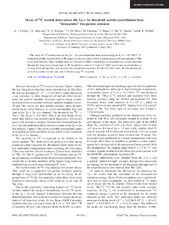| dc.creator | Charity, R. J. | |
| dc.creator | Mercurio, K. | |
| dc.creator | Sobotka, L. G. | |
| dc.creator | Elson, J. M. | |
| dc.creator | Famiano, M. | |
| dc.creator | Banu, A. | |
| dc.creator | Fu, C. | |
| dc.creator | Trache, L. | |
| dc.creator | Tribble, Robert E. | |
| dc.date.accessioned | 2011-09-13T21:26:47Z | |
| dc.date.available | 2011-09-13T21:26:47Z | |
| dc.date.issued | 2007 | |
| dc.identifier.citation | R. J. Charity, K. Mercurio, L. G. Sobotka, J. M. Elson, M. Famiano, A. Banu, C. Fu, L. Trache and Robert E. Tribble. Phys.Rev.C 75 051304 2007. "Copyright (2007) by the American Physical Society." | en |
| dc.identifier.uri | http://dx.doi.org/10.1103/PhysRevC.75.051304 | |
| dc.identifier.uri | https://hdl.handle.net/1969.1/127028 | |
| dc.description | Journals published by the American Physical Society can be found at http://publish.aps.org/ | en |
| dc.description.abstract | The decay of C-10 excited states to the 2p+2 alpha exit channel has been studied using an E/A=10.7 MeV C-10 beam inelastically scattered from a Be-9 target. Levels associated with two-proton decay to the ground state of Be-8 have been observed. These include states at 5.18 and 6.54 MeV which decay by sequential two-proton emission through the long-lived ground state of B-9. In addition, states at 5.3 and 6.57 MeV were found in which there is no long-lived intermediate state between the two proton emissions. For the 6.57 MeV state, the two protons are preferably emitted on the same side of the decaying C-10 fragment. | en |
| dc.language.iso | en | |
| dc.publisher | American Physical Society | |
| dc.subject | ENERGY | en |
| dc.subject | Physics | en |
| dc.title | Decay of C-10 excited states above the 2p+2 alpha threshold and the contribution from "democratic" two-proton emission | en |
| dc.type | Article | en |
| local.department | Physics and Astronomy | en |


